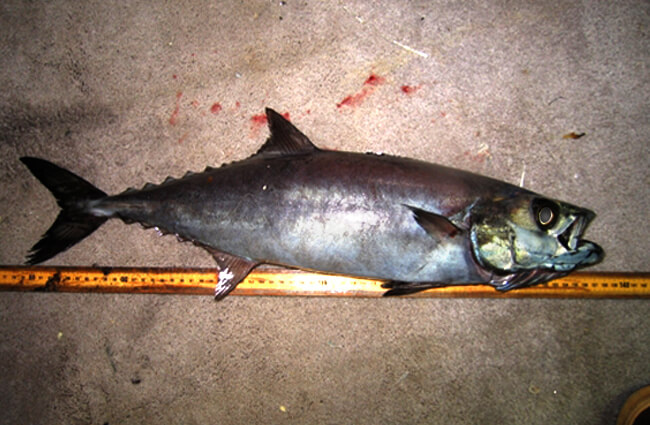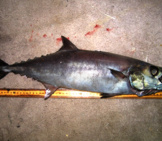Escolar is a species of fish in the Gempylidae family. Other members of the family include the snoek and other snake mackerels. Researchers recognize these fish as distant relatives to mackerels, tuna, butterfish, and more.
This fish is best known for its tendency to cause digestive issues when consumed. Read on to learn about the Escolar.
Description of the Escolar
This large fish has dark colored scales that grow darker with age. Older fish have nearly black coloration. You can easily recognize them by the short finlets past their dorsal fins, which have a similar appearance to that of some species of tuna.
Large adults reach lengths of 6 ft. or more, though most measure about 5 ft. long. The heaviest individuals reach nearly 100 lbs.
Interesting Facts About the Escolar
You can sometimes find this fish in sushi restaurants. Learn more about this species, and why you should potentially think twice before eating it, below.
- Keriorrhea – These fish cannot process some of the fatty acids found in their diet, primarily wax esters. The wax ester builds up in the fish’s body, and when people eat the fish the high oil content can result in digestive upset like stomach cramps.
- Consumption – Researchers recommend consuming no more than six ounces of this fish in a sitting to reduce the likelihood of keriorrhea. Unfortunately, some people unknowingly eat more when the restaurants label the fish as “white tuna.”
- Banned Fish – Regardless of precaution, you cannot eat this fish in Japan or Italy, because both have banned its consumption due to the risk of keriorrhea. In fact, Japan banned the species in 1977 and labeled it toxic.
Habitat of the Escolar
This fish lives primarily over the continental slope, or regions where the coast gradually deepens into the sea. It prefers benthopelagic habitats near the bottom and in the water column. Most occupy waters between 600 and 3,500 feet deep.
Their habitat preferences vary based on the time of day. During the daytime they move to deeper waters closer to the bottom. At night they move closer to the surface to feed.
Distribution of the Escolar
You can find this species in coastal regions across tropical, subtropical, and temperate zones. They live along the coast in these regions. In the Atlantic Ocean, their range extends from northeast Canada to southern Brazil, and from France and Spain to South Africa.
From there, their range extends around Africa up to Yemen, and across to Malaysia and Australia. You can find them along the coasts of most Indo-Pacific islands. In the eastern Pacific, they range from southern Canada along the coast of North America and down to Chile.
Diet of the Escolar
This species has carnivorous feeding habits, which means that it eats other animals. It hunts nocturnally, and swims upward in the water column to search for prey. Its primary prey include squid and small fish, as well as crustaceans like shrimp.
Escolar and Human Interaction
Humans do not directly target this fish species, but they do catch them as bycatch when fishing for tuna. Though this activity impacts them to some extent, their populations do not face direct threat from the tuna fishery. However, this capture as bycatch has resulted in a decrease of the average adult size of the fish in the past.
The IUCN currently lists the species as Least Concern.
Domestication
Humans have not domesticated this fish in any way.
Does the Escolar Make a Good Pet
No, this species would not make a good pet. They reach sizes much too large to keep in a home aquarium.
Escolar Care
People do not generally keep this species in aquariums. Hypothetically, you would need an immensely large tank, as they grow quite large. Additionally, you would need to feed them fish and squid as their diet, and replicate their natural pH and temperature for them to thrive.
Behavior of the Escolar
Researchers know little about their typical behavior. We know that this species participates in daily vertical migrations, where they swim into deeper water during the day and closer to the surface at night. They have nocturnal feeding habits, and hunt in waters closer to the surface at night.
Reproduction of the Escolar
Again, researchers know very little about this species. They breed via spawning, where the females release their eggs and the males fertilize them outside of the body. After the eggs hatch, the young emerge as pelagic larvae, which drift in the water and feed as they grow.



![Illustration of an Escolar Illustration of an EscolarPhoto by: Illustrations of the Zoology of South Africa [Public domain]](https://animals.net/wp-content/uploads/2020/01/Escolar-2-650x425.jpg)


![Illustration of an Escolar Illustration Of An Escolarphoto By: Illustrations Of The Zoology Of South Africa [Public Domain]](https://animals.net/wp-content/uploads/2020/01/Escolar-2-162x141.jpg)
![Red Angus Closeup of a beautiful Red Angus cowPhoto by: U.S. Department of Agriculture [pubic domain]https://creativecommons.org/licenses/by/2.0/](https://animals.net/wp-content/uploads/2020/03/Red-Angus-4-238x178.jpg)












![Red Angus Closeup of a beautiful Red Angus cowPhoto by: U.S. Department of Agriculture [pubic domain]https://creativecommons.org/licenses/by/2.0/](https://animals.net/wp-content/uploads/2020/03/Red-Angus-4-100x75.jpg)

